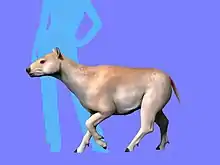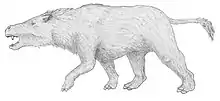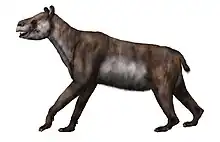| Hegetotheriopsis | |
|---|---|
| Scientific classification | |
| Domain: | Eukaryota |
| Kingdom: | Animalia |
| Phylum: | Chordata |
| Class: | Mammalia |
| Order: | †Notoungulata |
| Family: | †Hegetotheriidae |
| Subfamily: | †Hegetotheriinae |
| Genus: | †Hegetotheriopsis Kramarz & Paz 2013 |
| Type species | |
| Hegetotheriopsis sulcatus Kramarz & Paz 2013 | |
Hegetotheriopsis is an extinct genus of hegetotheriid notoungulate. It lived from the Late Oligocene to the Early Miocene, and its fossilized remains are found in Argentina.
Description
This genus is poorly known due to the fragmentary nature of its fossils ; a comparison with some of its better-known relatives tends to indicate that it was roughly the size of a modern agouti. Hegetotheriopsis is defined by the presence of both archaic and derived characteristics. It had very high-crowned and open-rooted (euhypsodont) molars, with cementum and devoid of dimple in the adult dentition. The center of the lingual wall of the upper molars featured a small groove, less marked than in several of its relatives such as Prosotherium and Propachyrucos. The first upper premolar was devoid of lingual sulcus, while the third and fourth upper premolars were molariform. A vestigial parastilar groove was located on the second and third upper premolars. The anteorbital margin was devoid of zygomatic plate.
Classification
Hegetotheriopsis sulcatus was first described in 2013, based on fossil remains found in the Chubut Province of Argentine Patagonia, in terrains dated from the Early Miocene. Other remains, found in the Cabeza Blanca locality of the Sarmiento Formation and attributed to the same species, are dated from the Late Oligocene. Furthermore, fossils of this genus have also been found in the Agua de la Piedra,[1] Cerro Bandera, and Chichinales Formations of Mendoza, Neuquén, and Río Negro Provinces of Argentina. Hegetotheriopsis is a member of the family Hegetotheriidae, a group of small-sized Notoungulates, roughly similar to lagomorphs or rodents. The real affinities of the genus are not clear, and the descriptors, Kramarz and Paz, noted some archaic characteristics, excluding it from the two subfamily of hegetotheriids (Hegetotheriinae and Pachyrukhinae) and also found in the family Archaeohyracidae, usually considered ancestral to the family.[2] Subsequent studies have instead recovered Hegetotheriopsis as a specialized hegetotheriid, attributed to the subfamily Hegetotheriinae.[3][4]
References
- ↑ Hernández Del Pino, Santiago; Seoane, Federico; Cerdeño, Esperanza (2022). "New craniodental information and taxonomic decisions of the typotherians (Notoungulata) from the late Oligocene of Mendoza, central-western Argentina". Acta Palaeontologica Polonica. 67. doi:10.4202/app.00974.2022. hdl:11336/202725. ISSN 0567-7920.
- ↑ Kramarz, Alejandro Gustavo; Paz, Ernesto Rodrigo (2013). "Un Hegetotheriidae (Mammalia, Notoungulata) basal del Mioceno temprano de Patagonia". Revista Mexicana de Ciencias Geológicas (in Spanish). 30 (1): 186–195. ISSN 1026-8774.
- ↑
- F. D. Seoane, S. R. Juñent, and E. Cerdeño. 2017. Phylogeny and paleobiogeography of Hegetotheriidae (Mammalia, Notoungulata). Journal of Vertebrate Paleontology 37(1):e1278547:1-13
- ↑ A. G. Kramarz and M. Bond. 2017. Systematics and stratigraphical range of the hegetotheriids Hegetotheriopsis sulcatus and Prohegetotherium sculptum (Mammalia: Notoungulata). Journal of Systematic Palaeontology 15(12):1027-1036
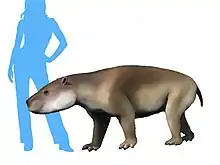
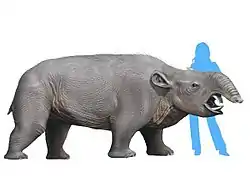

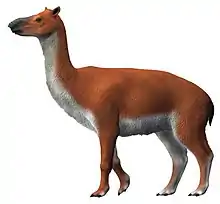
.jpg.webp)
